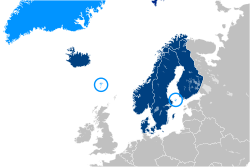
Back Nordiese Raad Afrikaans المجلس الشمالي Arabic Conseyu Nórdicu AST Паўночны савет Byelorussian Северен съвет Bulgarian Kuzul an Norzh Breton Nordijsko vijeće BS Consell Nòrdic Catalan Severská rada Czech Cyngor Nordig Welsh
Nordic Council
| |
|---|---|
 Member states shown in dark blue; and regions of member states shown in light blue. | |
 | |
| Secretariat Headquarters | |
| Official languages | [1] |
| Type | Inter-parliamentary institution |
| Membership | 5 sovereign states 2 autonomous territories 1 autonomous region |
| Leaders | |
• President | |
• Vice-President | |
| Establishment | |
• Inauguration of the Nordic Council | 12 February 1953 |
| 1 July 1962 | |
• Inauguration of the Nordic Council of Ministers | July 1971 |
| Area | |
• Total | 6,187,000 km2 (2,389,000 sq mi) |
| Population | |
• 2019 estimate | 27.5 million |
• Density | 4.4/km2 (11.4/sq mi) |
| GDP (PPP) | 2018 estimate |
• Total | US$1.6 trillion |
• Per capita | US$62,900 |
| GDP (nominal) | 2018 estimate |
• Total | US$1.7 trillion |
• Per capita | US$65,800 |
| Currency | |
Website www | |
| Part of a series on |
| Scandinavia |
|---|
 |


The Nordic Council is the official body for formal inter-parliamentary Nordic cooperation among the Nordic countries. Formed in 1952, it has 87 representatives from Denmark, Finland, Iceland, Norway, and Sweden as well as from the autonomous areas of the Faroe Islands, Greenland, and Åland. The representatives are members of parliament in their respective countries or areas and are elected by those parliaments. The Council holds ordinary sessions each year in October/November and usually one extra session per year with a specific theme.[3] The council's official languages are Danish, Finnish, Icelandic, Norwegian, and Swedish, though it uses only the mutually intelligible Scandinavian languages—Danish, Norwegian, and Swedish—as its working languages.[4] These three comprise the first language of around 80% of the region's population and are learned as a second or foreign language by the remaining 20%.[5]
In 1971, the Nordic Council of Ministers, an intergovernmental forum, was established to complement the council. The Council and the Council of Ministers are involved in various forms of cooperation with neighbouring areas in Northern Europe, including the German state of Schleswig-Holstein, the Benelux countries and the Baltic states.[6][7][8]
- ^ "The Nordic languages | Nordic cooperation". www.norden.org. Archived from the original on 5 September 2019. Retrieved 4 February 2020.
- ^ a b "information about the 2023 presidency on the council website". Archived from the original on 4 February 2023. Retrieved 4 February 2023.
- ^ "The Nordic Council". Nordic cooperation. Archived from the original on 6 July 2020. Retrieved 23 August 2019.
- ^ "The Nordic languages". Nordic cooperation. Archived from the original on 5 September 2019. Retrieved 4 February 2020.
- ^ "Language". 6 August 2008. Archived from the original on 5 July 2017. Retrieved 1 June 2018.
- ^ ERR (22 June 2017). "Ratas meets with Benelux, Nordic, Baltic leaders in the Hague". ERR. Archived from the original on 26 July 2020. Retrieved 1 June 2018.
- ^ Tobias Etzold, "Nordic Institutionalized Cooperation in a Larger Regional Setting," in Johan Strang (ed.), Nordic Cooperation: A European Region in Transition, pp. 148ff, Routledge, 2015, ISBN 9781317626954
- ^ Offices outside the Nordic Region Archived 17 August 2018 at the Wayback Machine. Nordic Council of Ministers.
© MMXXIII Rich X Search. We shall prevail. All rights reserved. Rich X Search
